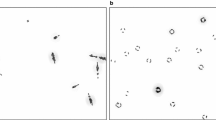Abstract
Collective behavior of swarms and flocks has been studied from several perspectives, including continuous (Eulerian) and individual-based (Lagrangian) models. Here, we use the latter approach to examine a minimal model for the formation and maintenance of group structure, with specific emphasis on a simple milling pattern in which particles follow one another around a closed circular path.
We explore how rules and interactions at the level of the individuals lead to this pattern at the level of the group. In contrast to many studies based on simulation results, our model is sufficiently simple that we can obtain analytical predictions. We consider a Newtonian framework with distance-dependent pairwise interaction-force. Unlike some other studies, our mill formations do not depend on domain boundaries, nor on centrally attracting force-fields or rotor chemotaxis.
By focusing on a simple geometry and simple distant-dependent interactions, we characterize mill formations and derive existence conditions in terms of model parameters. An eigenvalue equation specifies stability regions based on properties of the interaction function. We explore this equation numerically, and validate the stability conclusions via simulation, showing distinct behavior inside, outside, and on the boundary of stability regions. Moving mill formations are then investigated, showing the effect of individual autonomous self-propulsion on group-level motion. The simplified framework allows us to clearly relate individual properties (via model parameters) to group-level structure. These relationships provide insight into the more complicated milling formations observed in nature, and suggest design properties of artificial schools where such rotational motion is desired.
Similar content being viewed by others
References
Ben-Jacob, E., et al., 1997. Chemomodulation of cellular movement, collective formation of vortices by swarming bacteria, and colonial development. Physica A 238, 181–197.
Camazine, S., et al., 2001. Self-Organization in Biological Systems, Princeton University Press, Princeton.
Chuang, Y.L., et al., 2007. State transitions and the continuum limit for a 2d interacting, self-propelled particle system. Physica D 232, 33–47.
Couzin, I.D., et al., 2002. Collective memory and spatial sorting in animal groups. J. Theor. Biol. 218, 1–11.
Csahók, Z., Czirók, A., 2008. Hydrodynamics of bacterial motion. Physica A 243, 304–318.
Czirók, A., et al., 1996. Formation of complex bacterial colonies via self-generated vortices. Phys. Rev. E 54(2), 1792–1801.
Davis, P.J., 1979. Circulant Matrices, Wiley, New York.
D’Orsogna, M.R., et al., 2006. Self-propelled particles with soft-core interactions: Patterns, stability, and collapse. Phys. Rev. Lett. 96, 104302.
Grossman, D., Aranson, I.S., Ben-Jacob, E., 2008. Emergence of agent swarm migration and vortex formation through inelastic collisions. New J. Phys. 10, 023036.
Harvey-Clark, C.J., et al., 1999. Putative mating behavior in basking sharks off the Nova Scotia coast. Copeia 3, 780–782.
Hemmingsson, J., 1995. Modellization of self-propelling particles with a coupled map lattice model. J. Phys. A 28, 4245–4250.
Huth, A., Wissel, C., 1992. The simulation of movement of fish schools. J. Theor. Biol. 156, 365–385.
Kulinskii, V.L., et al., 2005. Hydrodynamic model for a system of self-propelling particles with conservative kinematic constraints. Europhys. Lett. 71(2), 207–213.
Levine, H., Rappel, W., Cohen, I., 2001. Self-organization in systems of self-propelled particles. Phys. Rev. E 63, 017101.
Li, Y.-X., Lukeman, R., Edelstein-Keshet, L., 2008. Minimal mechanisms for school formation in self-propelled particles. Physica D 237(5), 699–720.
Mach, R., Schweitzer, F., 2007. Modeling vortex swarming in daphnia. Bull. Math. Biol. 69(2), 539–562.
Marshall, J.A., Broucke, M.E., Francis, B.A., 2004. Formations of vehicles in cyclic pursuit. IEEE Trans. Automat. Contr. 49(11), 1963–1974.
Mogilner, A., et al., 2003. Mutual interactions, potentials, and individual distance in a social aggregation. J. Math. Biol. 47, 353–389.
Niwa, H.-S., 1994. Self-organizing dynamic model of fish schooling. J. Theor. Biol. 171, 123–136.
Niwa, H.-S., 1996. Newtonian dynamical approach to fish schooling. J. Theor. Biol. 181, 47–63.
Niwa, H.-S., 1998. Migration of fish schools in heterothermal environments. J. Theor. Biol. 193, 215–231.
Okubo, A., 1980. Diffusion and Ecological Problems: Mathematical Models, Springer, New York.
Okubo, A., Grunbaum, D., Edelstein-Keshet, L., 2001. The dynamics of animal grouping. In: Okubo, A., Levin, S. (Eds.), Diffusion and Ecological Problems: Modern Perspectives. Springer, New York
Parr, A.E., 1927. A contribution to the theoretical analysis of the schooling behaviour of fishes. Occ. Pap. Bingham Oceanogr. Collect. 1, 1–32.
Parrish, J., Edelstein-Keshet, L., 1999. Complexity, pattern, and evolutionary trade-offs in animal aggregation. Science 284, 99–101.
Parrish, J., Viscido, S., Grunbaum, D., 2002. Self-organized fish schools: an examination of emergent properties. Biol. Bull. 202, 296–305.
Ratushnaya, V.I., et al., 2007. Stability properties of the collective stationary motion of self-propelling particles with conservative kinematic constraints. J. Phys. A 40, 2573–2581.
Sakai, S., 1973. A model for group structure and its behavior. Biophys. Jpn. 13, 82–90.
Schneirla, T.C., 1944. A unique case of circular milling in ants, considered in relation to trail following and the general problem of orientation. Am. Mus. Novit. 1253, 1–25.
Silvester, J.R., 2000. Determinants of block matrices. Math. Gaz. 84, 460–467.
Suzuki, R., Sakai, S., 1973. Movement of a group of animals. Biophys. Jpn. 13, 281–282.
Topaz, C., Bertozzi, A., 2004. Swarming patterns in a two-dimensional kinematic model for biological groups. SIAM J. Appl. Math. 65(1), 152–174.
Vicsek, T., et al., 1995. Novel type of phase transition in a system of self-driven particles. Phys. Rev. Lett. 75(6), 1226–1229.
Weihs, D., 1974. Energetic advantages of burst swimming of fish. J. Theor. Biol. 48, 215–229.
Wilson, S.G., 2004. Basking sharks schooling in the southern Gulf of Maine. Fish. Oceanogr. 13, 283–286.
Author information
Authors and Affiliations
Corresponding author
Rights and permissions
About this article
Cite this article
Lukeman, R., Li, YX. & Edelstein-Keshet, L. A Conceptual Model for Milling Formations in Biological Aggregates. Bull. Math. Biol. 71, 352–382 (2009). https://doi.org/10.1007/s11538-008-9365-7
Received:
Accepted:
Published:
Issue Date:
DOI: https://doi.org/10.1007/s11538-008-9365-7




